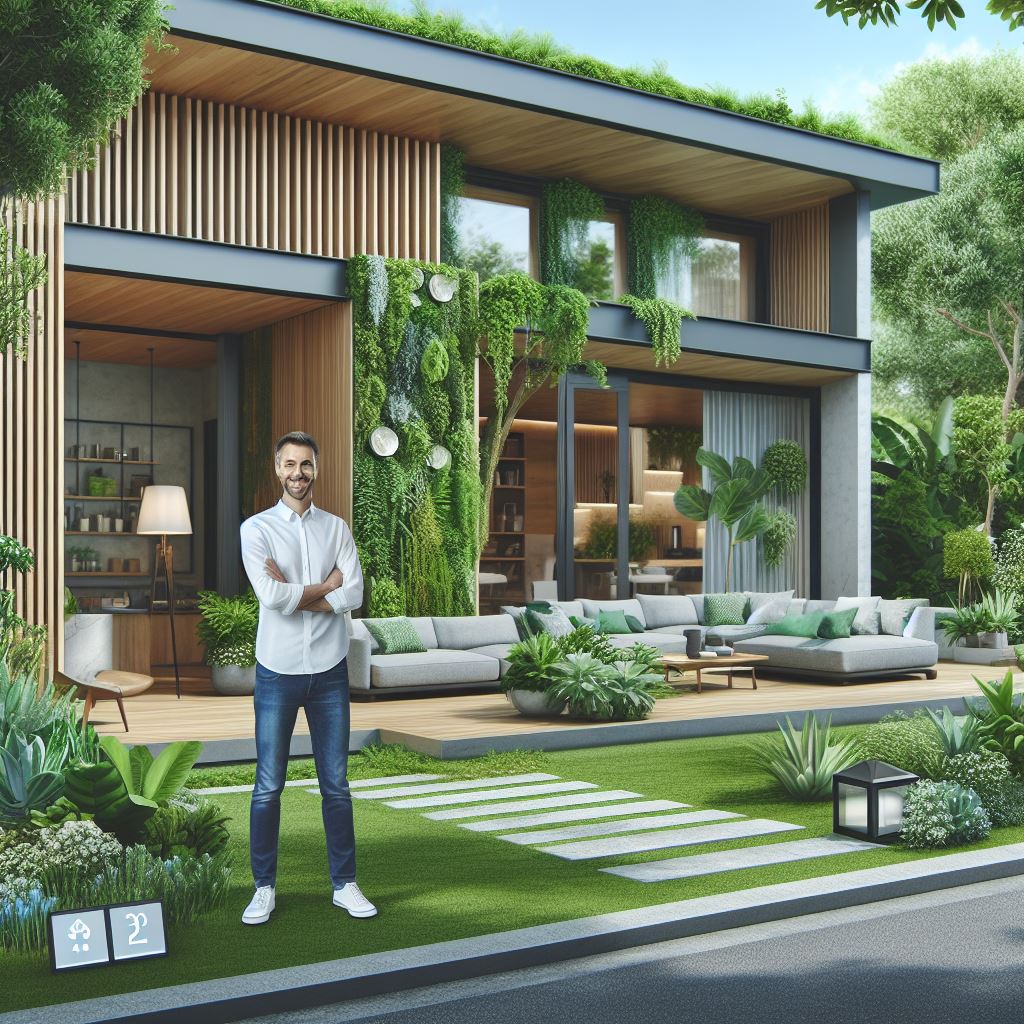Sustainable Urban Design: US Trends in 2024
Last Updated on February 4, 2024
Introduction
Sustainable urban design is a concept that focuses on creating cities that are environmentally friendly, socially inclusive, and economically viable.
It aims to address the challenges faced by urban areas by integrating sustainable practices into urban planning and development.
The importance of sustainable urban design in addressing environmental and social challenges cannot be overstated.
As cities continue to grow and face issues like climate change, pollution, and social inequality, sustainable urban design provides a framework for creating livable and resilient cities.
It promotes efficient resource use, reduces carbon emissions, improves air and water quality, promotes public health, and enhances social cohesion.
The purpose of this blog post is to discuss the upcoming trends in sustainable urban design in the US for the year 2024.
By identifying these trends, we can better understand the direction in which urban design is heading and how it can contribute to a more sustainable and equitable future.
These trends will shed light on innovative technologies, policies, and design principles that will shape the cities of tomorrow.
Join us as we explore the exciting possibilities of sustainable urban design in 2024 and beyond.
Sustainable Transportation
The increasing emphasis on eco-friendly transportation modes
In the dynamic landscape of urban design, sustainable transportation stands out as a pivotal trend shaping the future of cities across the United States in 2024.
Emphasizing eco-friendly modes of commuting, the nation is undergoing a transformative shift towards greener and cleaner transportation solutions.
One of the most notable trends is the escalating emphasis on eco-friendly transportation modes.
Cities are increasingly recognizing the need to reduce their carbon footprint, leading to a surge in the adoption of sustainable commuting options.
From electric scooters to shared bicycles, urban dwellers are choosing alternatives that not only benefit the environment but also promote a healthier lifestyle.
The growth and integration of electric vehicles in cities
The integration of electric vehicles (EVs) is a significant aspect of this shift. In 2024, EVs are no longer a novelty but a mainstream choice for conscientious commuters.
Cities are investing in charging infrastructure, incentivizing EV ownership, and collaborating with automakers to make electric vehicles more accessible to the public.
The result is a landscape where electric cars silently hum through city streets, reducing air pollution and dependency on fossil fuels.
The expansion of bike lanes and public transportation systems
Complementing the rise of electric vehicles is the expansion of bike lanes and public transportation systems.
Cities are reimagining their streetscapes, allocating more space for cyclists and pedestrians.
The expansion of bike lanes not only encourages sustainable modes of transportation but also contributes to a more active and vibrant urban lifestyle.
Simultaneously, public transportation systems are being revamped, emphasizing efficiency, accessibility, and environmental consciousness.
The use of alternative fuel sources and urban planning to reduce carbon emissions in transportation
Alternative fuel sources play a pivotal role in reducing carbon emissions in transportation.
Sustainable urban design in 2024 encompasses the integration of renewable energy sources and innovative technologies in transit systems.
From biofuels to hydrogen-powered buses, cities are exploring diverse options to create a more sustainable and resilient transportation infrastructure.
In fact, the sustainable transportation trends in US urban design for 2024 paint a picture of cities in motion towards a greener and more sustainable future.
As the nation navigates the complexities of urban living, the emphasis on eco-friendly transportation is steering us towards a healthier, more environmentally conscious tomorrow.
Read: Robotics in Construction: Changing US Industries
Green Spaces and Parks
The significance of green spaces in urban areas
In the evolving landscape of sustainable urban design, the importance of green spaces and parks has taken center stage, marking a transformative trend in the United States in 2024.
Cities are increasingly recognizing the significance of integrating nature into their urban fabric, not only for environmental reasons but also for the well-being of their residents.
The trend of increasing green spaces and parks in cities
Green spaces play a pivotal role in urban areas, acting as lungs for the city by absorbing carbon dioxide and releasing oxygen.
Beyond this environmental function, these spaces provide essential mental and physical health benefits for the residents.
The trend of increasing green spaces and parks within cities is a manifestation of the growing understanding of the positive impact nature has on urban dwellers.
The integration of nature-based solutions and sustainable landscape design
One notable aspect of this trend is the emphasis on nature-based solutions and sustainable landscape design.
Cities are incorporating eco-friendly materials and practices to ensure that the development of green spaces aligns with broader sustainability goals.
This includes using native plants, implementing efficient irrigation systems, and embracing green infrastructure to manage stormwater runoff.
The benefits of green spaces, such as improved air quality and mental well-being for residents
The benefits of green spaces are manifold. Improved air quality is a direct outcome of the increased vegetation, as plants act as natural air purifiers.
Furthermore, residents of cities with ample green spaces report enhanced mental well-being.
The tranquility and beauty of these areas offer a welcome escape from the hustle and bustle of urban life, reducing stress and promoting a sense of community.
Cities are witnessing the positive ripple effects of investing in green spaces.
From community gardens to expansive parks, these areas foster social interaction, contributing to a sense of belonging and unity among residents.
The increased focus on sustainable urban design in 2024 not only reflects a commitment to environmental responsibility but also a dedication to the holistic well-being of city dwellers.
In short, the surge of green spaces and parks in sustainable urban design is a defining trend in the United States in 2024.
As cities embrace the significance of nature in urban living, the integration of green spaces becomes not just a trend but a fundamental aspect of creating healthier, happier, and more sustainable communities.
Read: Chicago’s 2024 Commercial Property Boom Explained

Energy-Efficient Buildings
The need for energy-efficient buildings in sustainable urban design is gaining momentum as we move towards 2024.
Cities across the United States are prioritizing the reduction of energy consumption in buildings, aiming to minimize their environmental impact and create healthier living spaces.
The push for energy-efficient buildings in urban design
One of the key aspects of this trend is the push for the incorporation of sustainable materials and technologies in construction.
Building materials that have minimal environmental impact, such as recycled or locally sourced materials, are being favored.
Additionally, the use of energy-efficient technologies, like green roofs and advanced insulation, is becoming more widespread.
The incorporation of sustainable materials and technologies in construction
To further promote energy efficiency, urban designers are implementing energy-saving practices in buildings.
Solar panels are increasingly being integrated into the design of both commercial and residential buildings, harnessing the power of the sun to generate clean and renewable energy.
These panels not only reduce the reliance on traditional energy sources but also lower utility bills for building owners and occupants.
The use of energy-saving practices, such as solar panels and smart home systems
Another energy-saving practice being adopted is the use of smart home systems.
These systems allow homeowners to control heating, cooling, lighting, and other appliances remotely, optimizing energy usage and reducing waste.
Through the use of sensors and automation, smart homes can adjust energy consumption based on occupancy and preferences, thereby minimizing energy waste.
The trend towards green certifications and regulations for new construction projects
Furthermore, there is a growing trend towards green certifications and regulations for new construction projects.
Building certifications, such as LEED (Leadership in Energy and Environmental Design), are becoming more valuable and desirable for developers, as they highlight a building’s environmental performance.
These certifications provide assurance to occupants that the building meets high energy efficiency and sustainability standards.
Regulations are also being put in place to ensure that new construction projects comply with energy-efficient guidelines.
Local governments are imposing stricter requirements on buildings to meet certain energy efficiency criteria.
This not only benefits the environment but also encourages building owners and developers to embrace sustainable design practices.
In essence, the push for energy-efficient buildings in urban design is gaining significant traction as we approach 2024.
Sustainable materials and technologies are being incorporated into construction, while energy-saving practices like solar panels and smart home systems are becoming more prevalent.
Additionally, green certifications and strict regulations are signaling a shift towards environmentally conscious construction projects.
With these trends in place, the future of urban design looks promising, paving the way for energy-efficient and sustainable cities.
Read: Warehouse Investments: The 2024 Boom Explained
Resilient Infrastructure
The importance of resilient infrastructure in sustainable urban design
The importance of resilient infrastructure in sustainable urban design cannot be understated.
As cities continue to face the challenges of climate change, it is crucial to plan and design infrastructure that can withstand and adapt to the changing environment.
The trend of incorporating climate resiliency in infrastructure planning
One of the emerging trends in infrastructure planning is the incorporation of climate resiliency.
This means considering the potential impacts of climate change and designing infrastructure that can absorb shocks and recover quickly.
The use of green infrastructure, such as bioswales and rain gardens, to handle stormwater
Green infrastructure plays a significant role in enhancing the resilience of cities.
Bioswales and rain gardens, for example, are designed to absorb and filter stormwater, reducing the strain on traditional drainage systems during heavy rainfall events.
These nature-based solutions not only manage stormwater but also provide additional benefits such as improving air quality and creating habitats for wildlife.
The integration of renewable energy sources in infrastructure projects
Another key aspect of resilient infrastructure is the integration of renewable energy sources.
As cities strive to reduce their carbon footprint, incorporating solar panels, wind turbines, and other renewable energy technologies into infrastructure projects becomes crucial.
This not only reduces reliance on fossil fuels but also enhances the overall sustainability of urban design.
By combining resilient infrastructure with sustainable urban design principles, cities can create more livable and adaptive environments.
The benefits of resilient infrastructure go beyond climate change adaptation. It also contributes to economic growth, public health, and community well-being.
By investing in resilient infrastructure, cities can reduce the costs associated with frequent repairs and upgrades due to climate-related events.
Additionally, by incorporating green infrastructure, cities can enhance their natural assets, creating attractive and functional spaces for residents and visitors alike.
It’s important to note that resilient infrastructure requires long-term planning and collaboration among various stakeholders.
City planners, engineers, and policymakers must work together to identify vulnerabilities, develop innovative solutions, and secure funding for infrastructure projects.
In a nutshell, resilient infrastructure is a crucial component of sustainable urban design.
As cities continue to face the impacts of climate change, planning and designing infrastructure that can withstand and adapt to these challenges becomes paramount.
Incorporating climate resiliency, green infrastructure, and renewable energy sources are key trends shaping the future of infrastructure planning.
By embracing these trends and investing in resilient infrastructure, cities can create more resilient, livable, and sustainable urban environments for future generations.
Read: Industrial CRE: A Goldmine in 2024?
Community Engagement and Participation
In recent years, there has been a growing focus on community engagement in urban design projects.
This trend recognizes the importance of involving residents in decision-making processes to create sustainable and livable cities for the future.
Involving residents in decision-making processes
Urban design projects now emphasize the need to engage the local community.
Instead of top-down planning, there is a shift towards participatory decision-making.
This approach allows residents to voice their opinions, ideas, and concerns, ensuring that the final design reflects the needs of the community.
Participatory design and community-driven initiatives
Participatory design involves actively involving residents in the design and development phases of urban projects.
It promotes collaboration between stakeholders, such as architects, planners, and community members.
By working together, they can co-create solutions that address local needs and aspirations.
In addition, community-driven initiatives empower residents to take charge of their neighborhoods.
They encourage grassroots organizations and local leaders to initiate projects that enhance the urban environment.
Benefits of fostering a sense of ownership and community pride
A key benefit of community engagement in urban design is the fostering of a sense of ownership and community pride.
When residents are actively involved in decision-making processes, they feel a stronger connection to their neighborhoods.
This sense of ownership motivates them to take care of their surroundings and contribute to the well-being of the community.
Furthermore, community engagement can lead to increased social cohesion and civic participation.
Residents who have a voice in shaping their environment are more likely to participate in community activities and collaborate with their neighbors.
The growing focus on community engagement in urban design projects is a positive trend that contributes to creating sustainable and inclusive cities.
By involving residents in decision-making processes through participatory design and community-driven initiatives, cities can ensure that their development meets the diverse needs and aspirations of their inhabitants.
This approach not only fosters a sense of ownership and pride but also encourages social cohesion and civic participation, ultimately leading to more vibrant and livable urban environments.
As we look towards the future, it is crucial to prioritize community engagement and participation to create cities that are truly for their people.
Conclusion
In the dynamic landscape of urban development, 2024 has witnessed a significant shift towards sustainable urban design in the United States.
As we conclude our exploration of the key trends shaping the future of our cities, it is evident that sustainable urban design is not merely a trend but a transformative force poised to redefine the very fabric of our urban environments.
Summarizing the trends that have gained prominence this year, it is clear that green infrastructure has become a cornerstone in urban planning.
Cities across the US are embracing concepts like green roofs, vertical gardens, and permeable pavements to mitigate the environmental impact of urbanization.
The integration of renewable energy sources, such as solar panels on buildings and wind turbines in strategic locations, is also becoming increasingly common, ushering in an era of self-sufficient urban spaces.
Moreover, the emphasis on mixed-use developments is fostering communities where live, work, and play seamlessly coexist.
This approach not only reduces commuting but also promotes social cohesion and local economic growth.
Smart city technologies are being harnessed to optimize resource use, enhance transportation systems, and improve overall urban efficiency.
The transformative potential of sustainable urban design cannot be overstated.
Beyond the ecological benefits, these initiatives are creating cities that are more resilient to the challenges of the 21st century, from climate change to global health crises.
The integration of green spaces and sustainable transportation options not only enhances the quality of life for residents but also contributes to the psychological well-being of urban dwellers.


